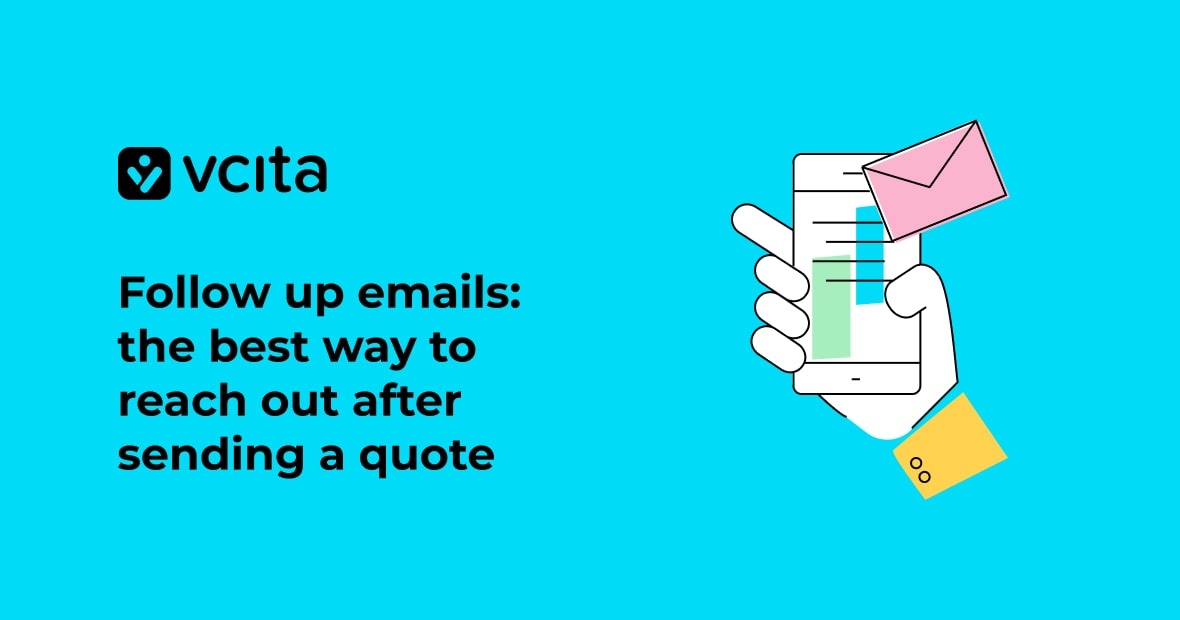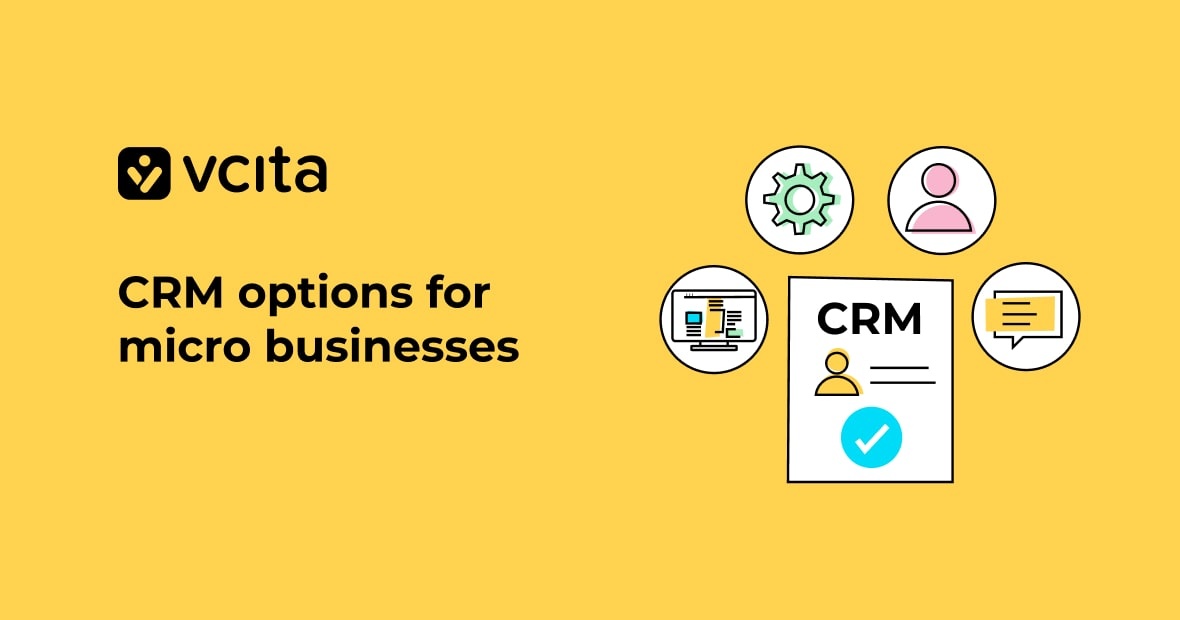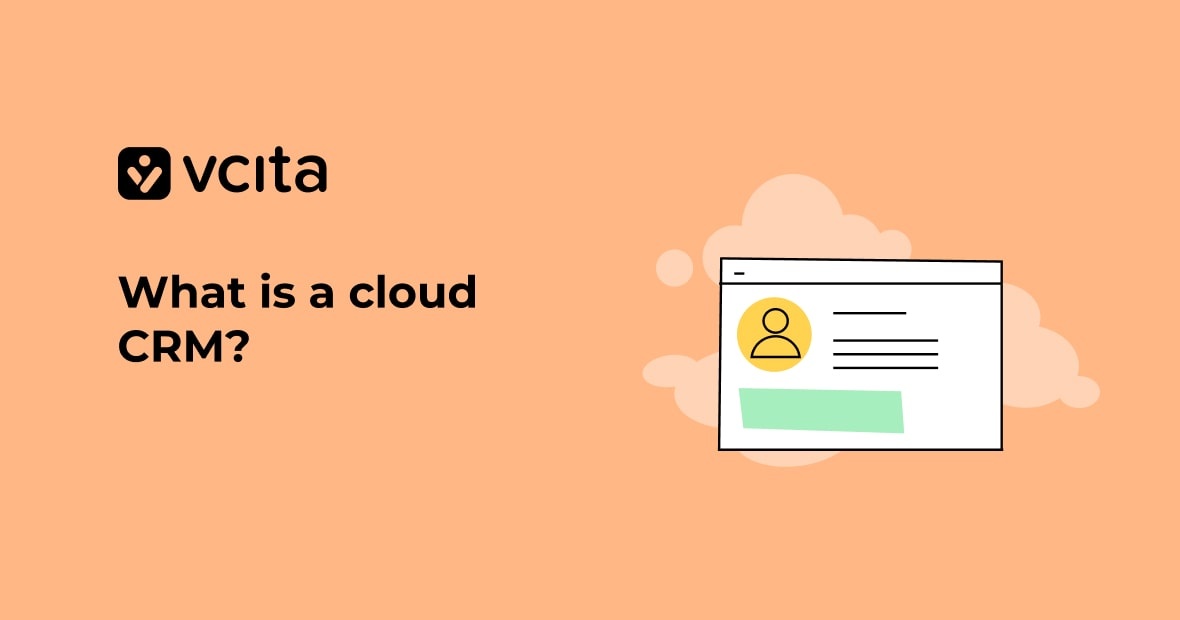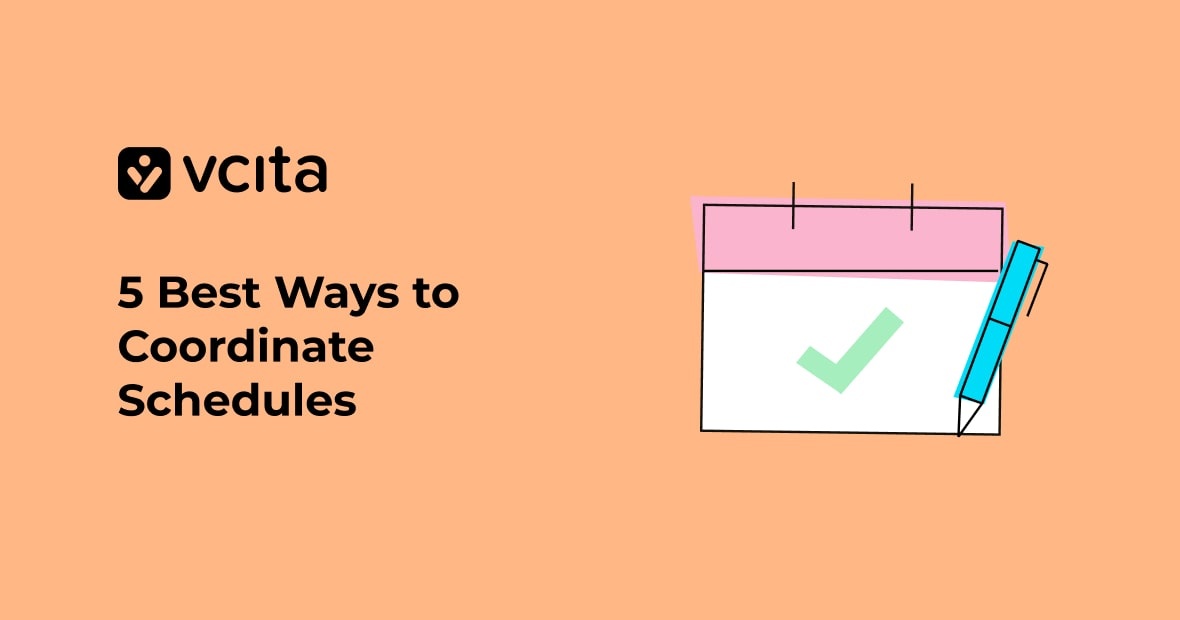Picture this scenario: you’ve had a long discussion with a client who requested a quote from you, so you spend some time putting it together and then send it to them. Even though you thought the conversation went well, it’s been a week and the client still hasn’t responded yet.
When you don’t hear back, it can be tempting to cut your losses and move on to the next client. But before you do, make sure you’ve sent them a great follow up email—it’s one way you can still convert a lead into a sale, provided your communication is clear and direct. Recent statistics show that the first follow up email is even more effective than the initial email, so don’t waste the opportunity to turn that quote into an invoice! Read on for some tips on best practices for follow up emails.
How long should you wait before sending a follow up email?
It’s a tricky decision. Wait too long, and your client might go with another service provider. Too soon, and your client might feel hounded. The perfect amount of time you should wait will depend on your industry, the type of service you’re providing, and your clients’ individual preferences. While there’s no definitive right answer, a good rule of thumb is to ask your client when you can follow up as you’re discussing the offer. As a default option, send your first follow up email 2 to 3 days after sending your quote.
Having multiple clients to follow up with can make it easy for those emails to slip through the cracks. Good client management software can help you avoid this by keeping track of your communication intervals for each lead. Being organized is one of the best ways to help you follow up with prospective clients and nurture your relationship with existing clients at the same time.
One thing to keep in mind
If you haven’t heard back about a quote you sent via email, keep in mind that there may be several different reasons your client hasn’t responded yet:
- Your client might be interested, but got busy and hasn’t found the time to write their response to you.
- Lots of emails get buried in clients’ inboxes or in their spam folder, so they may not have even seen your email.
- If your quote is for a more complex job, your client may need more time to think about whether or not it works for them, or to consult with someone else.
- If you sent your quote to a larger company, it’s possible your email has been sent to the wrong person, who hasn’t forwarded it along.
- Your client might be unsure about whether or not they want to work with you, or has decided that you aren’t a good fit.
With the above in mind, it’s easier to understand how important specificity is. When you’re writing your follow up email, don’t make assumptions about why your client hasn’t responded. If you do, you risk making your client dig through their inbox to find out what you sent them. Instead, include everything you sent in the first email so your clients can find your quote quickly and take action.
Did you know that adding a booking link directly to your email, makes your clients 5 times more likely to close an appointment with you?
With vcita scheduling software you can let your clients book appointments directly from your email in a few simple clicks.
How to structure a good follow-up email
In general, shorter emails are better, since they take less time to read—but they can be challenging to write. Your goal for a follow-up email should be to make it as concise as possible, ideally no longer than a few sentences or a short paragraph. If you don’t know where to begin, below are five steps for crafting the perfect follow-up email:
Step one: Define your goal
When you think about what the ideal outcome is, what does it mean in terms of the action that your client should take? What action do you need to take?
Would you like them to schedule an appointment, or would you like to schedule it? Do you need another meeting to discuss the quote? Is there a specific time frame that your client needs to act within in order to take advantage of a discount or promotional offer? Do you need a down payment before you start work?
Your goal for the email should be a small action that either you or your client can take right now. If what you’re asking for seems too big, consider offering a stepping stone like a free trial or consultation to establish more trust. This is especially important if you haven’t had much of a chance to build rapport with your client yet.
Step two: Write a great subject line
It’s easy to spend an hour or two crafting the perfect email, only to forget about the subject line. But a good subject line is important, since it can convince a hesitant client to open the email and hear you out—winning you a sale you might otherwise have lost.
Whether or not you want to get creative or stick to a more formal approach will depend on your business type. A hair salon might get away with a playful tone, while a therapist or life coach would be better off using a more serious voice. Whatever tone you decide to go with, make your subject line a short phrase that captures your goal. Here are a few examples of subject line types you might use to summarize your email:
- A subject line that asks a question
Writing your subject line in the form of a question accomplishes two things: first, it’s a summary of your goal, and second, it invites a response. Here’s an example of an email where the message is summarized in the subject line as a short question.
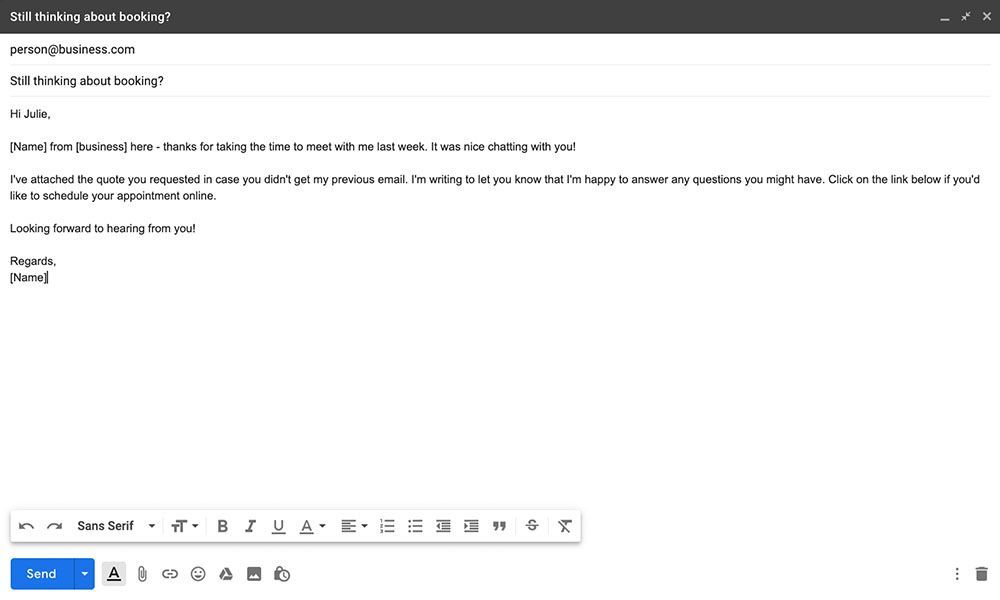
- Reframing the goal from the client’s perspective
Understanding your customers is a key part of selling a product or service. You know what you want from them, but why would they want what you have to offer? A subject line that hints at your client’s motivation for taking you up on your call to action is much more likely to engage them, even if it’s a single adjective like “great” that describes your services.
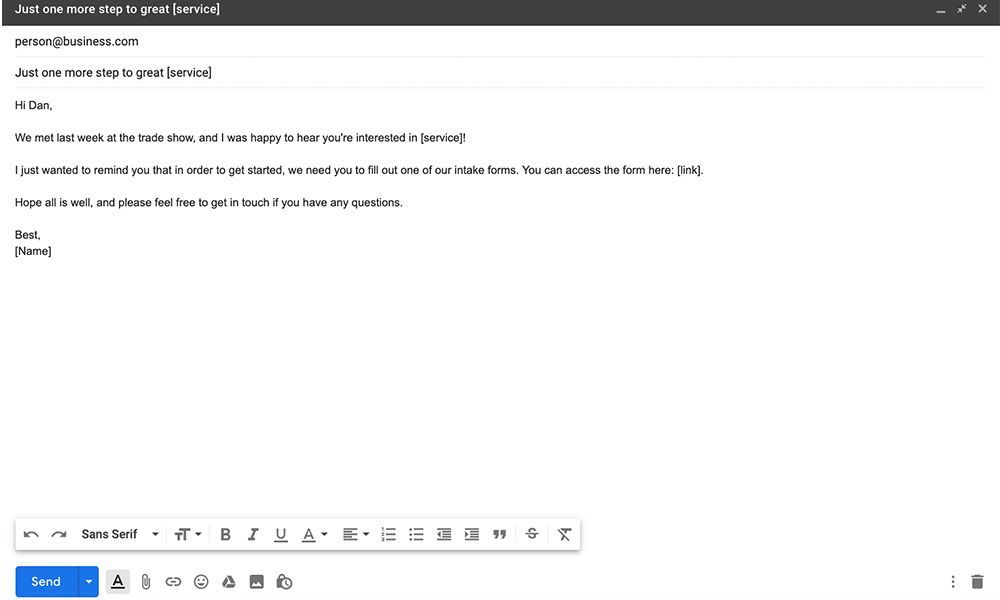
Step three: Refresh their memory
After the greeting, begin your email by reminding your client who you are and what you’re contacting them about. If your client is in conversation with multiple service providers, it will be easy to forget which one they’re talking to. State your name and the name of your business at minimum, and add any extra information if you have it—like where you met them or when you last spoke.
This is where a great CRM software can really shine – the more you are able to personalize the email, the more likely your client will be to remember you now and in the future. Keeping records of client details is vital in service professions like life coaching, so sending follow up emails that prove you’re listening will help you establish trust right off the bat.
- Mention the specific service and your business
In this example, the first two lines summarize the business, specific service, and all the points of contact between the client and service provider so far. This helps contextualize the email as a product of the client’s interest in the service. - Draw on past conversation
People are more likely to remember emotionally charged events, so if you’ve already had a conversation with your prospective client, bring up a minor detail they mentioned about their life. It doesn’t have to be big; any appropriate detail that makes your email more than strictly business can have an impact.
Step four: State your purpose
This is the part of the email where you tell your client why you’re sending it. As a default, think about how you’d complete the phrase, “I’m writing to _____,” and then rewrite it as necessary. Try to be as specific as possible.
Additionally, this part of the email tends to get bogged down with assumptions about why your client hasn’t responded: “I know you’re probably busy, but I wanted to remind you…” Avoid this, since it can be frustrating for clients if you’ve made a mistaken assumption about why they haven’t been in touch. Also avoid phrases like “just following up” or “just checking in.” These phrases are vague; they just add words to your email without adding information.
- Focus on what you can do for your client right now
Framing your purpose from your client’s perspective can help your email feel less like a high-pressure tactic and more like a friendly gesture. Think about how you can help the client make a decision at this stage. In this example, instead of asking for a response, the sender is issuing an invitation for the client to drop by so they can answer questions. - Give additional information
Following up on your quote doesn’t have to be the sole purpose of your email. You can combine it with information about special offers or discounts your client can take advantage of, while attaching your quote at the same time.
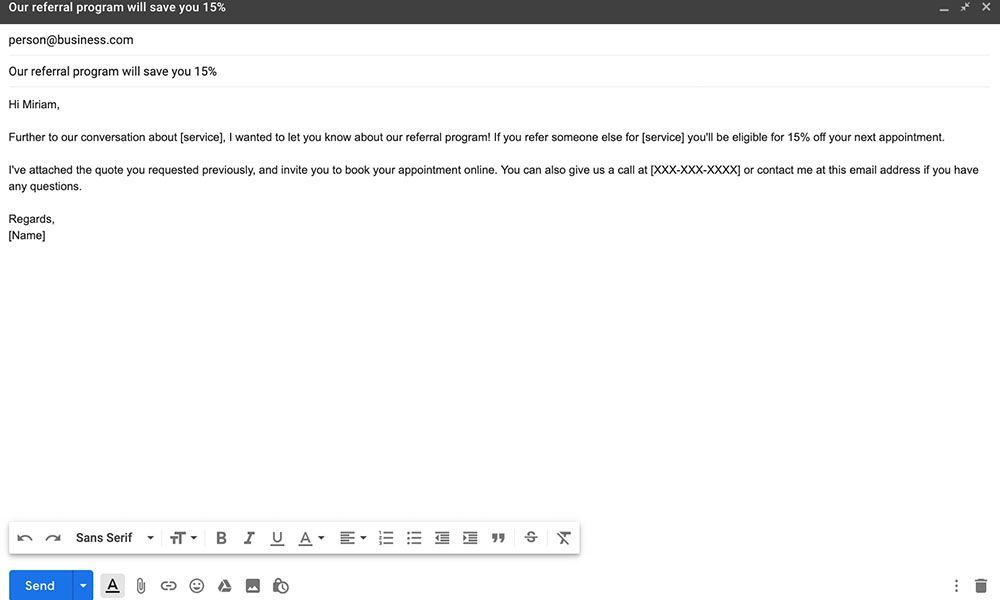
Step five: Call to action
Think about what you’d like your client to do, and write a call to action (CTA)—basically, a prompt that requests a specific action for them to take. Make that action as convenient for them as you possibly can. For example, if they need to fill out a form, having a link to a digital form will be much easier than having to fill out a form by hand.
Scheduling software like vcita will let you insert a “Schedule Now” button into your email to help your clients book appointments. That way, your clients can just click on the link and schedule meetings in your calendar at times you’re available, eliminating the back-and-forth emailing that usually happens when you’re trying to coordinate schedules.
Also think carefully about what you want CTA buttons embedded in your email to say. A good way to fine-tune your approach is to do A/B testing with different CTA buttons, where you compare the results of two slightly different emails to see which one converts more leads.
“Join today” vs. “Register today”
Calls to action are best when they incorporate a good action verb. This is an example of an email that you might send as a subscription-based provider, with a subject line that matches the CTA button. You might test a “join today” action button against a “register today” to see what one attracts the most customers.
Here are a few other CTA examples that you might do A/B testing on:
- “Schedule a free consultation” vs. “Schedule a free appointment” – for service-based businesses that offer the first consultation for free, it might be a good idea to test whether your clients prefer the word “consultation” or “appointment.”
- “Book a haircut” vs. “Book a stylist” – a hair salon might test the difference between whether clients respond more positively to the idea of a new haircut, or their time with a stylist.
- “Get started” vs. “Contact me” – this A/B test would be good for businesses that collect information about a client’s needs before booking, such as handyman or home cleaning service. This approach tests whether clients prefer the idea of starting a process, or whether they prefer the idea of starting a conversation.
Good follow up = good follow through
The worst type of follow-up email is no follow-up email. In addition to everything mentioned above, follow up emails communicate to your clients that you’re tuned in and will make every effort to be reachable. Timely follow up emails mean syncing your leads, calendar, and email marketing strategy so you don’t miss a beat when you’re contacted for a quote. An all-in-one platform like vcita can help you do everything seamlessly from one dashboard, so your calls to action draw in clients across your entire marketing suite.
























